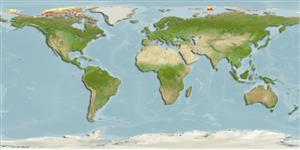Actinopterygii (ray-finned fishes) >
Perciformes (Perch-likes) >
Zoarcidae (Eelpouts) > Lycodinae
Etymology: Lycodes: Greek, lykos = wolf + Greek, suffix, oides = similar to (Ref. 45335).
Environment / Climate / Range
Ecology
Marine; bathydemersal; depth range 335 - 600 m (Ref. 11976). Deep-water, preferred ?
Arctic: Kara Sea in Russia and Beaufort Sea. May occur in Barents Sea.
Size / Weight / Age
Maturity: Lm ? range ? - ? cm
Max length : 27.3 cm SL male/unsexed; (Ref. 11954); max. published weight: 71.40 g (Ref. 11976)
Short description
Morphology | Morphometrics
Vertebrae: 104 - 109. Pelvic fins small (Ref. 4695). Uniformly dark brown, belly and lower part of head darker; mouth and gill cavity dark; peritoneum black (Ref. 4695).
Occurs on muddy bottoms (Ref. 4695). Benthic (Ref. 58426). Feeds on polychaetes, mollusks and crustaceans (Ref. 4695).
Life cycle and mating behavior
Maturity | Reproduction | Spawning | Eggs | Fecundity | Larvae
Anderson, M.E. and V.V. Fedorov, 2004. Family Zoarcidae Swainson 1839. Eelpouts. Calif. Acad. Sci. Annotated Checklists of Fishes (34):58. (Ref. 51665)
IUCN Red List Status (Ref. 115185)
CITES (Ref. 94142)
Not Evaluated
Threat to humans
Harmless
Human uses
More information
Common namesSynonymsMetabolismPredatorsEcotoxicologyReproductionMaturitySpawningFecundityEggsEgg development
Age/SizeGrowthLength-weightLength-lengthLength-frequenciesMorphometricsMorphologyLarvaeLarval dynamicsRecruitmentAbundance
ReferencesAquacultureAquaculture profileStrainsGeneticsAllele frequenciesHeritabilityDiseasesProcessingMass conversion
Tools
Special reports
Download XML
Internet sources
Estimates of some properties based on models
Phylogenetic diversity index (Ref.
82805): PD
50 = 0.5000 [Uniqueness, from 0.5 = low to 2.0 = high].
Bayesian length-weight: a=0.00234 (0.00106 - 0.00519), b=3.24 (3.04 - 3.44), in cm Total Length, based on LWR estimates for this (Sub)family-body shape (Ref.
93245).
Trophic Level (Ref.
69278): 3.2 ±0.40 se; Based on food items.
Resilience (Ref.
69278): Medium, minimum population doubling time 1.4 - 4.4 years (Preliminary K or Fecundity.).
Vulnerability (Ref.
59153): Moderate vulnerability (43 of 100) .
